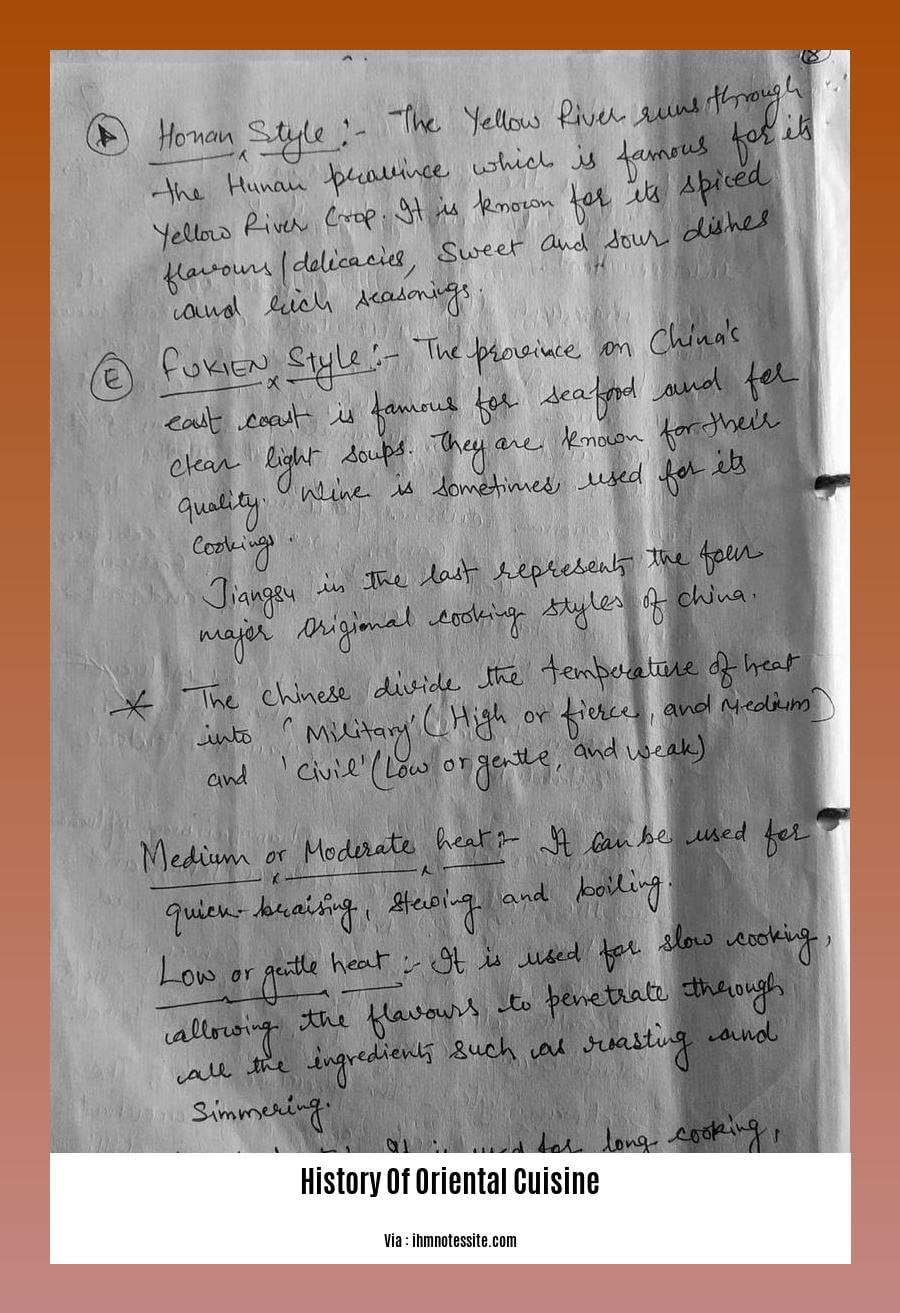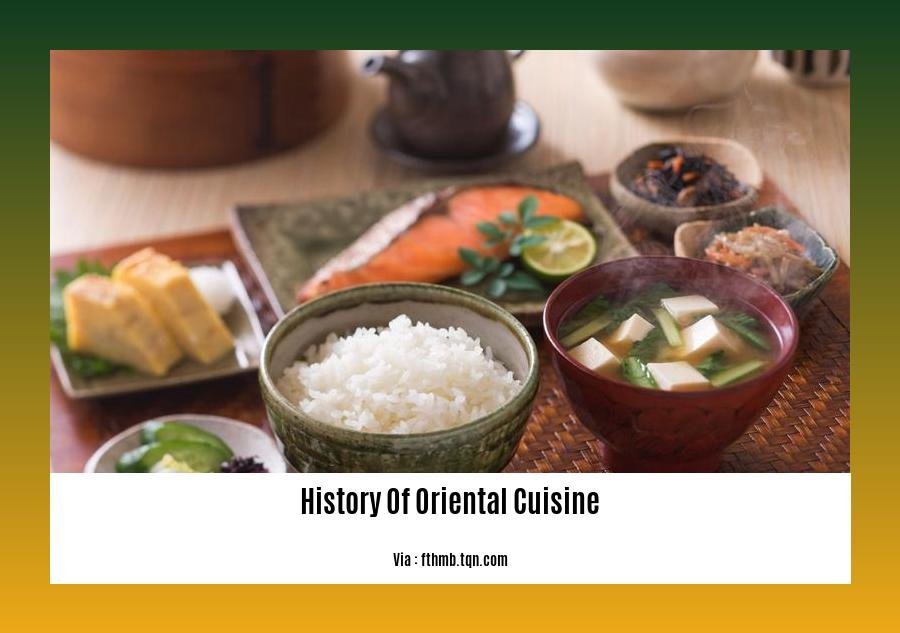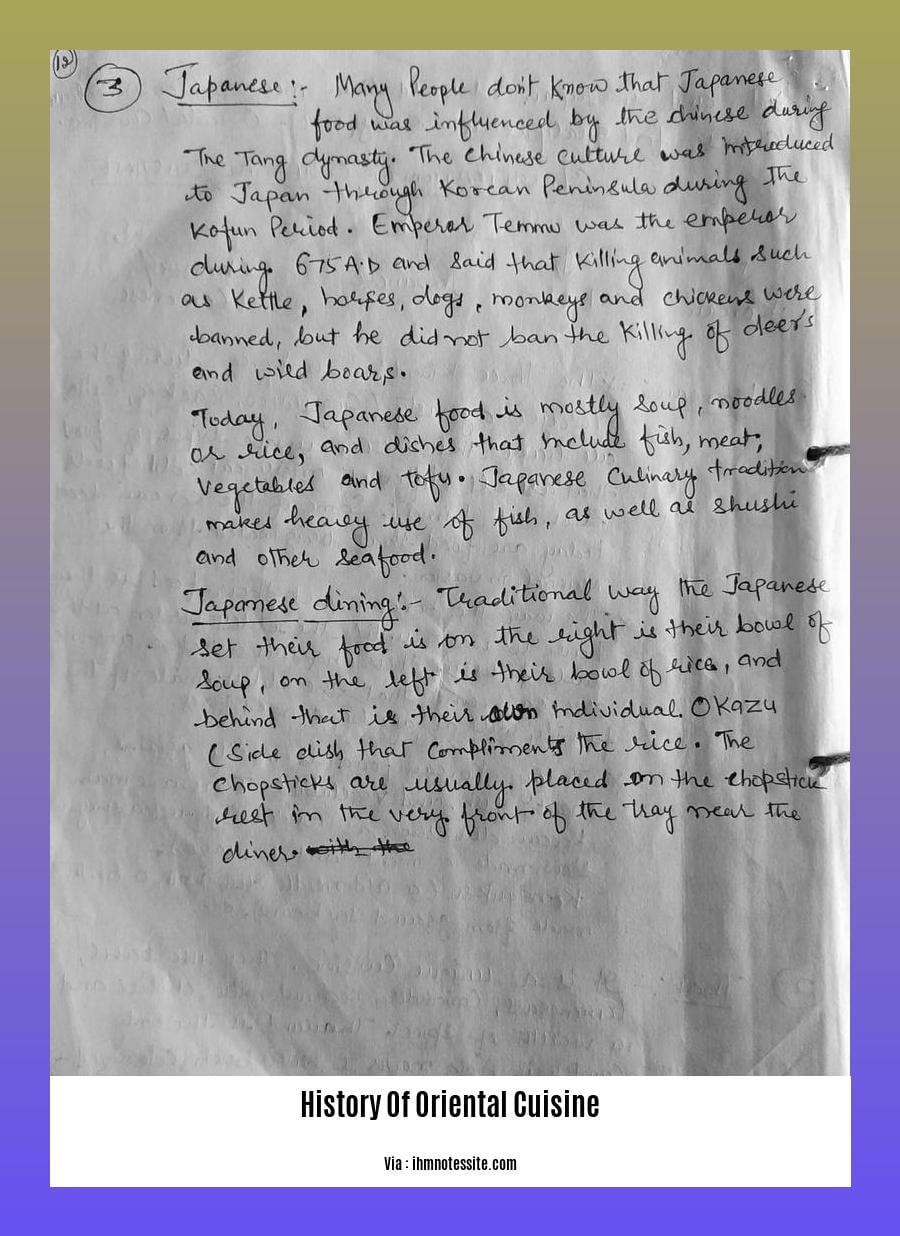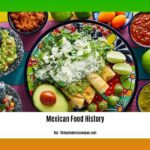Embark on a culinary adventure through the ages in [A Culinary Journey Through Time: Exploring the History of Oriental Cuisine]. Delve into the rich tapestry of Oriental cuisine as we trace its evolution from ancient origins to modern-day influences. Discover the captivating stories behind popular dishes, the intriguing fusion of flavors, and the remarkable resilience of culinary traditions.
Key Takeaways:
Oriental cuisine is a diverse culinary landscape encompassing East, Southeast, and West Asia.
It reflects the rich cultural heritage of each region, with a wide range of culinary traditions, ingredients, and cooking techniques.
Oriental cuisine has been influenced by historical and cultural factors, including trade, migration, and religious practices.
Popular dishes often have fascinating stories behind them, shedding light on the evolution of cooking techniques and ingredients.
Exploring Oriental cuisine is a journey through time, allowing us to appreciate the intricate tapestry of flavors and traditions that have shaped this culinary landscape.
History of Oriental Cuisine

Oriental cuisine, a tapestry of diverse culinary traditions, has a rich history that spans centuries, reflecting the cultural heritage and geographical influences of East, Southeast, and West Asia. Embark on a journey through time to explore its fascinating evolution:
Origins: Ancient Influences
The history of oriental cuisine can be traced back to ancient times, with evidence of early agricultural practices and the cultivation of crops like rice, wheat, and millet shaping the dietary foundation of various Asian civilizations. These early civilizations developed unique cooking techniques and culinary practices, utilizing locally available ingredients and seasonings to create dishes that reflected their distinct cultural identities.
Cultural Influences and Regional Variations
Over time, oriental cuisine was influenced by various cultural exchanges, trade routes, and migrations. The Silk Road, a network of trade routes spanning Asia, played a crucial role in the transmission of ingredients, spices, and culinary techniques between different regions. Buddhism and Confucianism also had a significant impact, promoting vegetarianism and influencing the use of ingredients like tofu and soy sauce.
As a result, distinct regional cuisines emerged, each with its own characteristics. Chinese cuisine, with its emphasis on fresh ingredients, wok cooking, and sauces, became renowned for dishes like Peking duck and Sichuan hot pot. Japanese cuisine, influenced by its island nation status, developed a focus on seafood and fermented foods, exemplified by sushi and miso soup. Southeast Asian cuisines, like Thai, Vietnamese, and Indonesian, incorporated tropical fruits, herbs, and spices, creating flavorful dishes like pad thai and pho.
Imperial Courts and Royal Cuisines
In many Asian cultures, the imperial courts played a significant role in shaping culinary traditions. Royal kitchens experimented with new ingredients and techniques, creating elaborate banquets and feasts that showcased the wealth and power of the ruling dynasties. These royal cuisines often influenced the development of regional cuisines, as chefs and cooks from the imperial kitchens shared their knowledge and skills with the wider population.
Modern Transformations and Global Impact
In recent centuries, oriental cuisine has undergone significant transformations, influenced by globalization, travel, and changing lifestyles. The increased availability of ingredients and the rise of fusion cuisine have led to a cross-pollination of culinary ideas and flavors. Oriental cuisine has become increasingly popular around the world, with restaurants serving authentic dishes and fusion creations, catering to a global audience seeking new and exciting culinary experiences.
Conclusion
The history of oriental cuisine is a testament to the enduring power of food to connect people and cultures. From its ancient origins to its modern-day global impact, oriental cuisine continues to captivate taste buds and tell the stories of diverse cultures and traditions. Whether it’s a bowl of steaming ramen from Japan, a plate of aromatic pad thai from Thailand, or a sumptuous Peking duck from China, each dish carries with it a legacy that spans centuries.
Would you like to know the fascinating history of Pizza’s introduction into America? Explore our page on the history of pizza in America, and learn every detail about its remarkable journey.
Chinese Cuisine History

China, the birthplace of one of the world’s oldest and most diverse cuisines, has a rich and storied culinary past. Its geography, history, and culture have combined to create a unique and complex cuisine that has influenced and been influenced by other culinary traditions around the world.
Key Takeaways:
Chinese cuisine has a long and rich history, dating back thousands of years.
It is a diverse cuisine, with regional variations reflecting the country’s vast geography and cultural diversity.
Chinese cuisine is based on the principles of balance, harmony, and flavor.
Chinese cooking techniques include stir-frying, steaming, braising, and roasting.
Chinese cuisine has been influenced by other cultures, including Mongolian, Tibetan, and Islamic cuisine.
The history of Chinese cuisine can be divided into several periods:
Ancient China (2070 BCE – 220 CE): During this period, the foundations of Chinese cuisine were laid, with the development of basic cooking techniques and the use of ingredients such as rice, noodles, and soy sauce.
Medieval China (220 – 960 CE): This period saw the rise of Buddhism and the introduction of new ingredients and cooking techniques from India and Central Asia.
Imperial China (960 – 1912 CE): During this period, Chinese cuisine flourished, with the development of new dishes and the refinement of existing ones. The imperial court was a major patron of the culinary arts, and many famous dishes were created during this time.
Modern China (1912 – present): This period has seen the rise of new culinary trends and the influence of Western cuisine. However, many traditional dishes continue to be popular, and Chinese cuisine remains one of the most popular cuisines in the world.
Chinese cuisine is as diverse as the country itself. From the spicy dishes of Sichuan to the delicate flavors of Cantonese cuisine, Chinese food offers a wide range of experiences to satisfy every palate.
Chinese cooking techniques are also diverse, reflecting the country’s vast geography and culinary traditions. Some of the most common techniques include stir-frying, steaming, braising, and roasting.
Chinese cuisine has been influenced by a number of different cultures over the centuries, including Mongolian, Tibetan, and Islamic cuisine. This has resulted in a rich and complex cuisine that is uniquely Chinese.
References
- Chinese Cuisine – History, Characteristics, and Major Dishes
- History of Chinese Food – The Complete Guide | Chopstick Chronicles
FAQ
Q1: How did the expansion of Han culture influence Chinese cuisine?
A1: The expansion of Han culture played a pivotal role in shaping Chinese cuisine. As the Han people migrated and settled in different regions, they brought their culinary traditions and ingredients with them. This led to the dissemination of Han cuisine throughout the country, contributing to the diverse culinary landscape of China.
Q2: What impact did traditional medicine have on the development of Chinese cuisine?
A2: Traditional Chinese medicine (TCM) greatly influenced Chinese cuisine. TCM practitioners emphasized the medicinal properties of food and believed that a balanced diet could prevent and cure illnesses. This led to the incorporation of herbs, spices, and other ingredients into Chinese cooking, not only for their flavor but also for their perceived health benefits.
Q3: How did shifting demands from elites contribute to the evolution of Chinese cuisine?
A3: The changing preferences and demands of the ruling elite had a significant impact on Chinese cuisine. As their tastes and dietary needs evolved, so too did the culinary practices and dishes popular in the imperial court. This led to the development of elaborate banquet dishes, the use of rare and exotic ingredients, and the refinement of cooking techniques.
Q4: In what ways did foreign influences affect the history of Chinese cuisine?
A4: Chinese cuisine has been influenced by various foreign cultures throughout history. Trade and cultural exchanges with neighboring countries, such as India, Persia, and Central Asia, introduced new ingredients, spices, and cooking techniques to China. These foreign influences were adapted and incorporated into Chinese cuisine, resulting in the creation of new dishes and flavors.
Q5: What are some of the most important characteristics of Chinese cuisine that appeared early in its history?
A5: The early development of Chinese cuisine saw the emergence of several fundamental characteristics that continue to define it today. These include the use of a variety of fresh and seasonal ingredients, a focus on balance and harmony in flavors and textures, and the mastery of cooking techniques such as stir-frying, steaming, and roasting. These characteristics laid the foundation for the rich and diverse cuisine that China is known for today.
- Mastering Leader in Spanish: The Complete Guide - April 19, 2025
- Uncovering Surprising Parallels: England Size Compared to US States - April 19, 2025
- Old Mexico Map: Border Shifts 1821-1857 - April 19, 2025
















